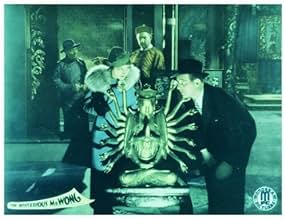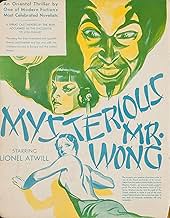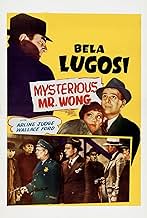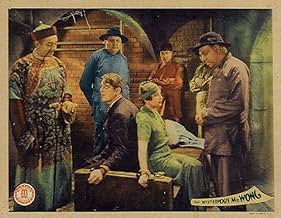Füge eine Handlung in deiner Sprache hinzuMr. Wong stops at nothing to gain the possession of 12 coins of Confucius, which will bring him great power.Mr. Wong stops at nothing to gain the possession of 12 coins of Confucius, which will bring him great power.Mr. Wong stops at nothing to gain the possession of 12 coins of Confucius, which will bring him great power.
Bela Lugosi
- Mr. Fu Wong aka Li See
- (as Béla Lugosi)
E. Alyn Warren
- Tsi Tung
- (as Fred Warren)
Robert Emmett O'Connor
- Officer 'Mac' McGillicuddy
- (as Robert Emmet O'Connor)
Edward Peil Sr.
- Jen Yu - Wong Henchman
- (as Edward Peil)
Ernie Young
- Chuck Roberts - Reporter
- (as Ernest F. Young)
Chester Gan
- Tung's Secret Service Agent
- (Nicht genannt)
James B. Leong
- Wong Henchman
- (Nicht genannt)
Richard Loo
- Bystander Outside Store
- (Nicht genannt)
Theodore Lorch
- Wong Henchman Thrown Into Pit
- (Nicht genannt)
Constantine Romanoff
- Bystander at Store with Chinese makeup
- (Nicht genannt)
Forrest Taylor
- Wong Henchman
- (Nicht genannt)
Beal Wong
- Killing Bystander
- (Nicht genannt)
Empfohlene Bewertungen
That bottom of the barrel movie mill, Monogram, gives its all in this ridiculous but fun film about mysterious happenings in a pseudo Chinatown. Bela Lugosi is the power-hungry overlord searching for the 12 Coins of Confucius which will allow him to become the Boss of Bosses. True to the era and for no particular reason except to add to the running time, all Chinese, good or bad, are murdered, tortured and generally abused.
Throw in Wallace Ford and Arline Judge as the newspaper reporter and his girlfriend for some unfunny comic relief and E. Alyn Warren (who???) as Lugosi's arch enemy and you are off and running. The dialogue will remind you of the Charlie Chan films with those "Confucious say......." aphorisms.
Two of the most humorous things in this mish-mash (and there are many) are: (1) Lugosi playing an Oriental with that heavy Hungarian accent; and (2) after trying every type of torture to make his arch enemy crack under pressure, Lugosi kicks him in the shins. Priceless!!! It's foolish, tacky, poverty row at its finest..........what fun!!!!
Throw in Wallace Ford and Arline Judge as the newspaper reporter and his girlfriend for some unfunny comic relief and E. Alyn Warren (who???) as Lugosi's arch enemy and you are off and running. The dialogue will remind you of the Charlie Chan films with those "Confucious say......." aphorisms.
Two of the most humorous things in this mish-mash (and there are many) are: (1) Lugosi playing an Oriental with that heavy Hungarian accent; and (2) after trying every type of torture to make his arch enemy crack under pressure, Lugosi kicks him in the shins. Priceless!!! It's foolish, tacky, poverty row at its finest..........what fun!!!!
Bela Lugosi changes genres in 1934's "The Mysterious Mr. Wong"; a detective mystery set in LA's Chinatown. As Li See he is the low profile owner of a herb shop patronized for comic relief by a stereotypical Irish cop. But he is secretly the title character who will stop at nothing to gather all twelve of the Coins of Confucius. Once he has all twelve he will have special powers in Keelat (a Chinese province) from where he apparently can inflict his evil on a wider scale.
All these coins have found there way to 1930's LA for some reason and Wong's minions spend the first part of the movie murdering assorted Chinese characters to gain possession of each coin. You quickly learn which guys are his minions because they are the only ones in the movie who wear "Billy Jack" style flat brim hats.
Newspaper reporter Jason Barton (Wallace Ford) begins to investigate the murders, both alone and in the company of his paper's cute and plucky switchboard operator Peg (Arline Judge). Judge becomes one of the earliest scream queens as talking pictures had only been around a few years. The chemistry and banter between Ford and Judge is the best thing about "The Mysterious Mr. Wong". It is the equal of Gable and Colbert in "It Happened One Night" but unfortunately their scenes together are not the central focus of the story.
Wong has a beautiful niece (played by Lotus Long) who periodically appears in short scenes of no actual consequence to the plot. She is in a constant state of great distress about her uncle's evil activities and it is implied that Wong kills her after she leads Barton and Peg to him.
The movie never explains why Wong regards this as a bad thing because it appears to be exactly what he wanted her to do. But this is an illustration of many logic problems in the screenplay, which are best ignored. Just enjoy the great dialogue despite the flaws in storyline logic. Some stuff essential to the plot was probably trimmed to reduce the running time. Barton and Peg are given one of the coins by a disembodied hand while they are having dinner in a Chinese restaurant. Viewers have to fill in a lot of missing action to connect this improbable coincidence with earlier events.
The Hollywood racist and ethnic stereotypes abound, my favorite is a Chinese university professor who heads up the Department of Orientology.
Lugosi is sinister in a nice self-parodying way, with an accent that is more vaguely foreign than Chinese. His Mr. Wong is entirely unrelated to Boris Karloff's later detective series of the same name.
If you enjoy early cinema this one is highly recommended. The suspense won't keep you on the edge of your seat but the Ford and Judge interplay is timeless
Then again, what do I know? I'm only a child.
All these coins have found there way to 1930's LA for some reason and Wong's minions spend the first part of the movie murdering assorted Chinese characters to gain possession of each coin. You quickly learn which guys are his minions because they are the only ones in the movie who wear "Billy Jack" style flat brim hats.
Newspaper reporter Jason Barton (Wallace Ford) begins to investigate the murders, both alone and in the company of his paper's cute and plucky switchboard operator Peg (Arline Judge). Judge becomes one of the earliest scream queens as talking pictures had only been around a few years. The chemistry and banter between Ford and Judge is the best thing about "The Mysterious Mr. Wong". It is the equal of Gable and Colbert in "It Happened One Night" but unfortunately their scenes together are not the central focus of the story.
Wong has a beautiful niece (played by Lotus Long) who periodically appears in short scenes of no actual consequence to the plot. She is in a constant state of great distress about her uncle's evil activities and it is implied that Wong kills her after she leads Barton and Peg to him.
The movie never explains why Wong regards this as a bad thing because it appears to be exactly what he wanted her to do. But this is an illustration of many logic problems in the screenplay, which are best ignored. Just enjoy the great dialogue despite the flaws in storyline logic. Some stuff essential to the plot was probably trimmed to reduce the running time. Barton and Peg are given one of the coins by a disembodied hand while they are having dinner in a Chinese restaurant. Viewers have to fill in a lot of missing action to connect this improbable coincidence with earlier events.
The Hollywood racist and ethnic stereotypes abound, my favorite is a Chinese university professor who heads up the Department of Orientology.
Lugosi is sinister in a nice self-parodying way, with an accent that is more vaguely foreign than Chinese. His Mr. Wong is entirely unrelated to Boris Karloff's later detective series of the same name.
If you enjoy early cinema this one is highly recommended. The suspense won't keep you on the edge of your seat but the Ford and Judge interplay is timeless
Then again, what do I know? I'm only a child.
Modern viewers must be forgiven if they're confused over the genre of this Bela Lugosi film. It's crime pulp, something hardly seen today except in Quentin Tarantino films. The focus is on the villain, in this case Lugosi as a Chinese(!) gangster tracking down the twelve coins of Confucius. The only mystery is how he will be stopped and whether or not he will escape to cause trouble another day.
Wallace Ford is fun as the wry reporter (reminding me a bit of Chevy Chase). And Arline Judge is as cute as a button as the switchboard operator he's trying to romance. It all takes place in Chinatown, for some reason, with plenty of casual bigotry, altho its sometimes turned around on the bigot for comic comeuppance (as when Ford talks pidgin to a Chinese girl only to be answered in fluent English).
If you like the era, this is a fun film and a good example of the genre. It's got the menacing thugs, mysterious murders, and secret passageways you expect and a bit of sassy dialog to boot.
Wallace Ford is fun as the wry reporter (reminding me a bit of Chevy Chase). And Arline Judge is as cute as a button as the switchboard operator he's trying to romance. It all takes place in Chinatown, for some reason, with plenty of casual bigotry, altho its sometimes turned around on the bigot for comic comeuppance (as when Ford talks pidgin to a Chinese girl only to be answered in fluent English).
If you like the era, this is a fun film and a good example of the genre. It's got the menacing thugs, mysterious murders, and secret passageways you expect and a bit of sassy dialog to boot.
1934's "The Mysterious Mr. Wong" casts Hungarian Bela Lugosi in something of a dual role: Fu Wong the titular character a 'Mad Manchurian' (a Poverty Row Fu Manchu) seeking 12 coins given out by Confucius on his death bed, which would enable the owner to command the Chinese province of Keelat, and his elderly masquerade as herb dealer Li See, whose shop is connected to Wong's inner sanctum through a secret panel. The picture begins with a series of murders that have authorities believing there's another Tong war, Wong's henchmen successfully delivering 11 coins, each corpse identified by a piece of Chinese writing. The downward spiral introduces Wallace Ford as roving reporter Jason Barton, wisecracking with Irish cop McGillicuddy (Robert Emmet O'Connor), various comings and goings repeated endlessly as the elusive final coin is passed from person to person. Arline Judge gets in a few shots as Barton's sweetheart, but the comic relief overwhelms the rest of the film, leaving Lugosi in a vacuum to carry the burden on his own, as he so often did in low budget productions (not enough screen time at 18 minutes). Ford also opposed Bela in "Night of Terror" and "The Ape Man," but this nauseating newshound is his worst yet, on par with Lee Tracy's unfunny antics opposite Lionel Atwill in "Doctor X." This was Lugosi's only film for the original Monogram company, soon to be absorbed into Herbert J. Yates' Republic Pictures, a new Monogram emerging from the ashes to kick off Sam Katzman's infamous 9 picture deal in 1941. An entirely new Mr. Wong inspired by Charlie Chan would later allow Boris Karloff a crime solving respite during the horror blackout of the late 30s, a six film series concluding in 1940 with one shot Wong Keye Luke doing the honors in the closer "Phantom of Chinatown." Concluding a year playing heroes in "The Black Cat" and "The Return of Chandu," Lugosi returned to full time villainy back to back in both this and Columbia's forgotten programmer "The Best Man Wins," before well remembered roles in MGM's "Mark of the Vampire," and Universals "The Raven" and "The Invisible Ray."
It has some good sequences, but overall "The Mysterious Mr. Wong" doesn't really live up to its promise. With Bela Lugosi starring as a shadowy villain, a decent plot idea that involves artifacts from ancient history, and a couple of interesting-looking settings, it had the makings of a good B-feature, at least as long as you are willing to overlook some stereotypes and the like for the sake of entertainment.
Lugosi's character is interesting, as is his hideout, and Lugosi also gets the chance to play two different sides of his character. The script seems to miss a lot of opportunities, though, because the character really never comes to life as well as it could have. Wallace Ford actually gets the best opportunities, as the reporter who, along with Arline Judge, tries to contend with Wong's plots. Ford does pretty well in the role, and he has plenty of energy.
The story likewise holds some possibilities that are never realized. There are some fairly good sequences with the characters inside Wong's secret lair, but at other times the story doesn't always make a lot of sense, and the interesting ideas involved in Wong's quest for the coins are mostly mentioned only in passing. It's all right as light entertainment, but it could have been more.
Lugosi's character is interesting, as is his hideout, and Lugosi also gets the chance to play two different sides of his character. The script seems to miss a lot of opportunities, though, because the character really never comes to life as well as it could have. Wallace Ford actually gets the best opportunities, as the reporter who, along with Arline Judge, tries to contend with Wong's plots. Ford does pretty well in the role, and he has plenty of energy.
The story likewise holds some possibilities that are never realized. There are some fairly good sequences with the characters inside Wong's secret lair, but at other times the story doesn't always make a lot of sense, and the interesting ideas involved in Wong's quest for the coins are mostly mentioned only in passing. It's all right as light entertainment, but it could have been more.
Wusstest du schon
- WissenswertesThe "Mr. Wong" played here by Bela Lugosi is not the same character as the "Mr. Wong" later played by Boris Karloff and Keye Luke in a series of six films. Lugosi's Fu Wong is a villain, while the James Lee Wong of the series is a detective in the vein of Charlie Chan. All seven movies were produced by the same Poverty Row studio, Monogram Pictures, but have no other affiliation.
- PatzerMr. Wong, played by Bela Lugosi, speaks English with a thick Hungarian accent.
- VerbindungenEdited into Who Dunit Theater: The Mysterious Mr. Wong (2015)
Top-Auswahl
Melde dich zum Bewerten an und greife auf die Watchlist für personalisierte Empfehlungen zu.
Details
- Erscheinungsdatum
- Herkunftsland
- Sprache
- Auch bekannt als
- Jeziva misterija
- Drehorte
- Produktionsfirma
- Weitere beteiligte Unternehmen bei IMDbPro anzeigen
- Laufzeit1 Stunde 3 Minuten
- Farbe
- Sound-Mix
- Seitenverhältnis
- 1.37 : 1
Zu dieser Seite beitragen
Bearbeitung vorschlagen oder fehlenden Inhalt hinzufügen

Oberste Lücke
By what name was The Mysterious Mr. Wong (1934) officially released in Canada in English?
Antwort
































